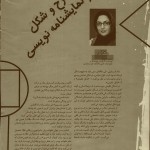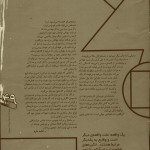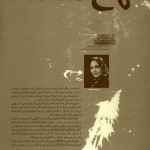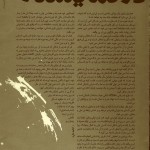In order to achieve the principles of puppet play, it is better to review one of the components of play, called as “plot”.
Every play is the consequence of a “plot”, thus every theatrical text evolves by expansion and development of “plot”.
The plot of a play, novel, short story or narrative poem is a summary of the work whose constituents are affected by three- dimensional drama. Plot is designed as it can change into a play or bring on the stage.
The plot of a play is obvious and it can be tracked easily. Also it should have a consistent structure, meaning that it shouldn’t be time consuming and the events must happen on a logical order and they should be believable. The events can place randomly next to each other. The events of the plot usually come out of
the heart of event, unless the writer does it intentionally. A good plot can attract the addressee to the end of the work.
Plot is not the same as the story. Edward Morgan Forster, an English writer and critic, explains their difference as “The story contains an outstanding feature; it makes the audience eager to know what happens in continue”.
Forster’s definition of story is its simplest literal form which is considered as a foundation for many literal forms including story, short story, play and scenario. Narration might be the most fundamental element of the story, meaning the successive retelling of the event.
Event means a situation or circumstance with no balance. The narration of a balanced motionless condition upon which no motion catches the eye, does not result in story.
Story starts where a concrete or conceptual thing losses its constant stable state. Therefore no story is created by saying: “Once upon a time, there was a king who governed on a land”, even by adding some sentences such as “He gained all what he wished” no story is evolved.
But if it is said “once the king saw a young girl and fell in love with her”, we can say the story starts, because love making is not a static situation. So it is considered an event and by adding “The young boy who loved the girl, harbored a grudge against king” it is possible to say that we contribute to extend the story. We continue to reach a stable condition and evolve the story.
Plot is a smart form of story and it contains a mystery which makes the reader to trail the reason of mystery and its performance.
Plot is the account of events which is expressed according to a cause and effect relation in mainstream of the story in a compressed and interrelated way.
Forster says in definition of plot: “Time sequence is retained but the causal sense casts a shadow. Plot can accompany with a mystery so that it can be extended completely, because time sequence makes it suspended and keeps it distance from the story as much as the limitations give chance”.
According to a research made by Gerald Printsch based upon linguistics “no plot is evolved before 3 or 4 events gathered, 2 of which at least happen in different times, even though the causation rule governs these events”. In his point of view, story expresses just the time sequence.
Forster adds: “we can’t explain the plot for a cave man or a despot. These kinds of people usually try to satisfy their curiosity and it is possible to keep them awake only by “then what?”! Plot requires “wisdom and memory”, wisdom for seeking the reason of mysteries and memory for not to forgetting the past events. Therefore, plot requires an intellectual wise reader”.
We don’t intend to neglect the story by discussing the viewpoints of Foster and etc., but the writer’s concern to the form or context is important.
Every artwork is evolved via the form made by artist and the form is defined as organizing the components to reach a generality. To create such an organization, the artist applies typical principles intentionally, thus gives a form to the artwork. This form or structure links the interrelationships between the components.
Therefore, every artwork bears a unique form and it is a mistake to say that only a typical form is suitable for all plays or to select the best form as a pattern. Playwrights in 20th century created an incredible diversity in structural system of their works which is undeniable. We can’t say that today the traditional principles and old structures have completely left all the plays. To understand the concept of “form”, it is better to review the viewpoints of Sam Smily on this area. He tries to approach the concept of form in his article. He suggests two broad species of dramatic form for plays: “mimetic form” and “didactic form”.
In mimetic form, the writer deals with human being and his condition, but in didactic form, the writer thinks about the change of human condition and to persuade the addressee, so it deals more with argumentative thoughts. In most of the plays for children, we confront with the dramatic form.
On the other hand, we can probe playwriting based upon its movement including horizontal and vertical movement. The plays with horizontal movement contain a causative structure in which an event is the reason of another one and all the events are interrelated. In order that the reasons get clear, motivations of the characters are important and usually plot is responsible for. In these plays, Action emphasizes on improvement and progress and movement from an action to the next is constantly continued to reach peak of excitement.
Puppet play “Rumpelstiltskin” is a good example.
Jean Matson has written the play borrowing a story of Grimm Brothers with the same title. The writer applied the story as a plot and designed it with a horizontal movement. “The Golden Stone” is also another example of the play for children with a horizontal movement and didactic form. The plot of the play is as follows:
“Sam, as the young son of the family leaves his education to start an adventure and prospect gold. He intends to travel to a far land in company with many other prospectors. His younger brother, Jerry, owns a dog called Champ. The whole family love Champ for its loyalty and culture. Champ disappeared after Sam left home. Jerry searched for it for a while and as he was disappointed to find it, he never left home. On the other hand it was announced that some dealers were selling the non-husky dogs instead of huskies to prospectors. Passing a long path and while debarking the ship, Sam saw a man who was hitting a dog to force it carrying a bobsled while the dog was just baying. Sam approached and found that the dog was Champ. So he paid all his travel expense to buy Champ and returned home. Sam has returned home with a golden stone which bears emotions and feelings”.
Puppet play “Swan Lake” also has a scientific structure. Movement flows from an action to another one so that it finally reaches the climax. The plot is evolved as follows:
“Siegfried is a young prince who falls in love with Odette, the queen of Swan Lake. He can undo her hex of being Swan by his love. So he swears with her but he forgets his swear at his birthday celebration and decides to get married with another girl. At the same time the Lake becomes stormy and Siegfried finds out his mistake, so he rushes towards Lake, but the storm drowns him. After a while, when the Lake stops storminess, There seen only two swans on the Lake”.
To achieve a plot, you can practice plot writing right now and then think to its form. You can try the didactic form and horizontal movement.
Since natural elements, such as birth, childhood, youth, old age and death or sun rise, sun set, night, seasons and etc. all have an ascendant movement from beginning to the middle, then to the climax and end, it seems that such a movement harmonizes more with human nature and so many writers apply this kind of movement in their plots.
In works for children, we confront more with such a plot. Although this method of writing and movement is valuable and considerable, it might be necessary in recent era to write a plot according to the evolutions in current era for the sake of media progress, its evolutions and the evolution in children’s playing species. In Vertical structure, most of the events are unscientifically and casually.






